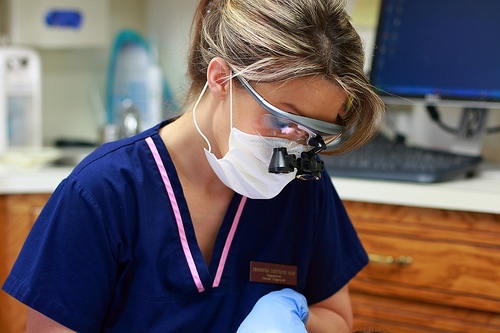July 26th, 2023

Sleep apnea is an increasingly common medical condition, and one that can have a truly devastating effect on the waking life of the sufferer. Those who suffer from the disorder may find that they suffer any or all of the following side effects:
- Saliva has several important jobs, and one of them is to protect and heal your tongue, your gums, and the inside of your mouth. Snoring and sleep apnea dry out your mouth, meaning there isn’t enough time for your saliva to do all this vital work.
- Over an extended period of sleep apnea, it’s likely that the sockets of your teeth will begin to dry out overnight as a result of your gasping for air and snoring between breaths. If this happens too frequently over a long a period of time, it can start to loosen your teeth.
- Those with sleep apnea often also practice bruxism, which is the habit of clenching and grinding your teeth together as you sleep. This can lead to all manner of problems, including TMJ disorder, damage to the enamel, headaches, and toothaches.
- For obvious reasons, sleep apnea does not lead to a particularly good night’s sleep. This means that sufferers are often tired and irritable, and suffer from the many other ill effects of sleep deprivation.
- While it is unclear whether the reasons behind this are correlative or causative, it has been suggested there are links between sleep apnea and cardiac arrests, depressive disorders, Type Two diabetes, cancerous tumors, “silent” strokes, and various complications of pregnancy.
While sleep apnea can be a troubling condition, Dr. Mark Goedecke and our team at Goedecke Family Dentistry will tell you it is eminently treatable. There are a number of ways to combat it, ranging from simple sleep hygiene to use of a CPAP machine. Of course, if it is possible for you to reduce your weight a little in a safe and healthy way, some have found that is also helpful in combating the problem. Sleep apnea is very easy to treat, once it has been correctly identified.
If you think you may be suffering from sleep apnea, or if you would like to know more about the condition, please give us a call at our convenient Mt. Pleasant office to schedule an appointment with Dr. Mark Goedecke.
July 26th, 2023

As you age, it becomes even more important to take good care of your teeth and dental health. According to the Centers for Disease Control and Prevention, approximately one-fourth of adults age 65 and older have no remaining teeth. What's more, nearly one-third of older adults have untreated tooth decay.
Oral health, regardless of age, is crucial to overall good health. Ideally, we all want to keep your natural teeth, but whether you're caring for natural teeth or dentures, advancing age may put older adults at risk for a number of oral health problems, including:
- Dry mouth
- Diminished sense of taste
- Root decay
- Gum disease
- Uneven jawbone caused by tooth loss
- Denture-induced tissue inflammation
- Overgrowth of fungus in the mouth
- Attrition (loss of teeth structure by mechanical forces)
- Oral cancer
These conditions may not be diagnosed until it is too late. If you want to feel good, stay healthy, and look great throughout life, you might be surprised what a difference a healthy mouth makes.
Here are some tips for maintaining and improving your oral health as you become older:
- Brush twice a day with a toothbrush with soft bristles. You may also benefit from using an electric toothbrush.
- Clean between your teeth once a day with floss or another interdental cleaner.
- If you wear full or partial dentures, remember to clean them on a daily basis. Take your dentures out of your mouth for at least four hours every day. It’s best to remove them at night.
- Drink tap water. Since most contains fluoride, it helps prevent tooth decay no matter how old you are.
- Quit smoking. Besides putting you at greater risk for lung and other cancers, smoking increases problems with gum disease, tooth decay, and tooth loss.
- Visit Goedecke Family Dentistry regularly for a complete dental checkup.
If you have any questions about keeping up with your oral hygiene at home, please give us a call!
July 19th, 2023

“Shouldn’t that be healthy gums,” you’re thinking? And, of course, you’re correct. Healthy gums are extremely important not only for our dental well-being, but for our overall physical health.
But that’s a subject for another blog! Today, we’re talking about healthy gum—chewing gum, that is. Because choosing the right chewing gum can actually improve your dental health.
Oral bacteria use the foods we eat, especially sugars and simple carbs, as fuel to produce acid. These acids attack our tooth enamel, gradually weakening the minerals in the tooth surface and allowing cavities to develop. Clearly, we want to reduce these acids to help prevent decay. Luckily, our bodies have a natural defense against acid attacks—saliva.
Saliva works to protect our enamel in three ways:
- It helps neutralize and wash away acids in the mouth.
- It rinses away the food particles which bacteria feed on.
- It strengthens teeth by providing the necessary minerals our enamel needs to “remineralize” after acids have weakened the tooth surface.
Studies have concluded that chewing sugarless gum for 20 minute after a meal can help prevent cavities. Why? Because chewing gum increases saliva production. You are actually reducing the effects of harmful acids, washing food particles away from your teeth, and strengthening weakened enamel with every stick! Some artificial sweeteners are even thought to inhibit the growth of the bacteria that lead to decay.
With all that in mind, it’s also healthy to know when you shouldn’t chew gum:
- When the gum contains sugar. Even with an increase in saliva production, bathing your teeth in sugar as you chew does your enamel no favors!
- When you wear braces. Gum can stick to your brackets and between your brackets and your wires. And while trying to clean gum from your appliance is no one’s idea of fun, an even more unpleasant possibility is the chance that gum might bend your wires out of shape. Sugarless gum is not quite as sticky as regular gum, but before you open that first pack, check with your orthodontist to see if you might be putting your orthodontic work at risk.
- When you have jaw problems such as TMD, TMJ or other temporomandibular concerns, or if you develop jaw pain while chewing gum.
- You should never give gum to a child too young to understand that it should not be swallowed. Beyond acting as a choking hazard, continual gum swallowing can lead to diarrhea, blockages, abdominal pain and other serious problems. Talk to your Dr. Mark Goedecke about the right age for chewing gum.
While chewing sugarless gum has the potential to improve dental health, remember it should never take the place of regular brushing and flossing—still the best way to prevent cavities at home. Talk to Dr. Mark Goedecke about the possible benefits of sugarless gum at your next visit to our Mt. Pleasant office, and we can make recommendations based on your individual dental history. Because whether it’s healthy gums or healthy gum, we’re here to help.
July 19th, 2023

An article was released to the public stating that dental X-rays contribute to a type of brain cancer. After reading an article like this, your first thought may be to avoid dental X-rays, but you may want to hold off on that quick judgment. As with any treatment we offer at Goedecke Family Dentistry, education is your most valuable tool in deciding what is best for you.
How often dental X-rays are taken is based on risk for infection, physical symptoms, and clinical findings. The American Dental Association (ADA) is a governing body over the dental profession. The ADA states, “ . . . healthy adults receive routine mouth X-rays every two to three years. Dental X-rays are recommended every one to two years for children and every 1.5 to three years for teens. Children often require more X-rays than adults because of their developing teeth and jaws and increased likelihood for cavities.”
A "caries risk category" often determines how often dental X-rays are taken. The most recent documented resource to determine a caries risk is Caries Management by Risk Assessment (CAMBRA). This was adopted by the ADA and is used by dental professionals giving interval recommendations for X-rays.
With knowledge of your risk for dental infection, you will be informed by Dr. Mark Goedecke of the interval at which dental X-rays should be taken. You can rest assured that the standards published by the ADA have been researched extensively and are there to protect your personal health and safety.
Dental X-rays are most commonly digital, which significantly reduces exposure. There is more radiation exposure from the sun or in an airplane than in a dental X-ray. It is common practice to use a lead apron with a thyroid collar for protection during X-ray exposure.
Having a cavity means having an active, potentially harmful infection. Diagnosing such infection with minimal exposure through digital dental X-rays at our Mt. Pleasant office does more good than harm.







